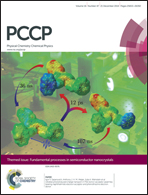Nanocrystalline silicon: lattice dynamics and enhanced thermoelectric properties
Abstract
Silicon has several advantages when compared to other thermoelectric materials, but until recently it was not used for thermoelectric applications due to its high thermal conductivity, 156 W K−1 m−1 at room temperature. Nanostructuration as means to decrease thermal transport through enhanced phonon scattering has been a subject of many studies. In this work we have evaluated the effects of nanostructuration on the lattice dynamics of bulk nanocrystalline doped silicon. The samples were prepared by gas phase synthesis, followed by current and pressure assisted sintering. The heat capacity, density of phonons states, and elastic constants were measured, which all reveal a significant, ≈25%, reduction in the speed of sound. The samples present a significantly decreased lattice thermal conductivity, ≈25 W K−1 m−1, which, combined with a very high carrier mobility, results in a dimensionless figure of merit with a competitive value that peaks at ZT ≈ 0.57 at 973 °C. Due to its easily scalable and extremely low-cost production process, nanocrystalline Si prepared by gas phase synthesis followed by sintering could become the material of choice for high temperature thermoelectric generators.

- This article is part of the themed collection: Fundamental Processes in Semiconductor Nanocrystals

 Please wait while we load your content...
Please wait while we load your content...